Green Snake Dream Bible Meaning: Temptation and Renewal
In the context of biblical symbolism, dreaming of a green snake suggests a complex interplay between spiritual growth and deception. The snake traditionally symbolizes cunning and evil, as indicated by the serpent in the Garden of Eden.
In contrast, the color green represents growth, renewal, and divine provision, as reflected in various scriptures. Consequently, a green snake could signify an impending period of personal or spiritual transformation, intertwined with challenges of moral integrity and temptation.
Understanding this symbolism requires deeper exploration into the intricate dynamics of spiritual and ethical themes inherent in such dreams.
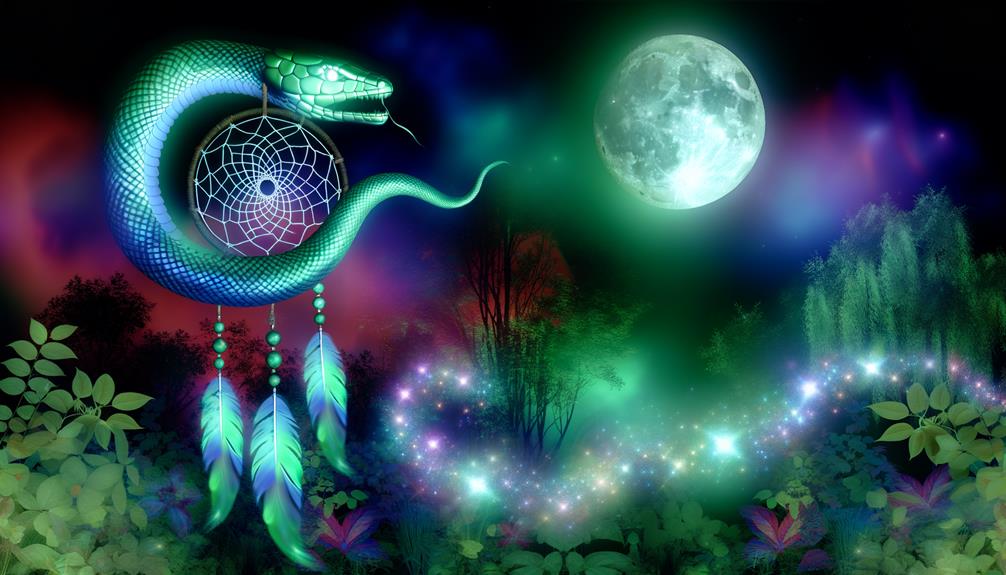
Green Snake Dream Bible Meaning: Symbolism of Temptation, Growth, and Spiritual Renewal
| Aspect | Biblical Meaning |
|---|---|
| Temptation & Deception | In the Bible, snakes often symbolize temptation and deception, as seen in the story of Adam and Eve. A green snake in a dream may represent spiritual challenges or deceit you need to guard against. |
| Growth & Renewal | The color green is often associated with growth, renewal, and healing. In this context, a green snake may signify transformation or spiritual growth after overcoming challenges. |
| Healing & Restoration | Green can also symbolize healing and restoration, indicating that confronting the snake (deception or temptation) can lead to spiritual recovery and growth. |
| Caution & Discernment | Seeing a green snake can be a warning to be cautious in certain areas of life, encouraging discernment and wisdom in navigating difficult situations. |
| New Beginnings | A green snake could also indicate new beginnings, especially in the spiritual realm, symbolizing the shedding of old ways and embracing a renewed path. |
Biblical Symbolism of Snakes

In biblical literature, snakes frequently symbolize both deception and evil, most prominently exemplified by the serpent in the Garden of Eden narrative. This serpent’s cunning nature catalyzed humanity’s fall, as it beguiled Eve into disobedience, leading to the original sin (Genesis 3:1-5).
Beyond Eden, snakes are recurrent motifs of treachery, as seen in Psalm 140:3, where venomous snakes’ tongues symbolize malevolent speech.
Additionally, Jesus’ admonition in Matthew 10:16 to be ‘wise as serpents‘ juxtaposes cunning with innocence, indicating potential duality.
The snake’s role in Moses’ staff transformation (Exodus 7:10-12) further complicates its symbolism, intertwining divine power with serpentine imagery.
Consequently, snakes in biblical texts often embody a complex interplay of danger, wisdom, and divine intervention.
Green Color in Biblical Context

The color green in the biblical context is frequently associated with growth, renewal, and life, symbolizing prosperity and restoration.
Numerous biblical references, such as Psalm 23:2, depict green pastures as a representation of divine provision and peace.
The spiritual significance of green extends to notions of hope and resurrection, vital themes within the Christian narrative.
Symbolism of Green
Symbolically, green in the biblical context often represents life, renewal, and prosperity, drawing from its frequent association with nature and growth. This color is emblematic of the flourishing of creation, reminiscent of verdant pastures and fertile lands.
The symbolism extends to spiritual rejuvenation, suggesting a state of divine favor and abundance. Analytical examination reveals that green embodies hope and the promise of new beginnings, resonating with themes of resurrection and eternal life.
Exegetically, its connotations of liveliness and rejuvenation underscore its significance in the biblical narrative, where it frequently serves as a metaphor for God’s providence and blessings. Consequently, green encapsulates a spectrum of positive spiritual and material connotations, aligning with the overarching biblical themes of life and growth.
Biblical References
Drawing from the symbolic richness of green, its biblical references further illuminate its profound theological implications.
Green is frequently associated with life, renewal, and growth, as evidenced in Psalm 23:2, where it is written, ‘He makes me lie down in green pastures.’ This imagery evokes divine provision and tranquility.
Furthermore, green symbolizes spiritual prosperity and flourishing, as seen in Jeremiah 17:8, ‘He will be like a tree planted by the water…its leaves are always green.’ This color consequently functions as a metaphor for spiritual vitality and God’s blessings.
It is crucial to recognize that these connotations provide a foundational understanding when interpreting dream symbols within a biblical framework, particularly in discerning divine messages and spiritual states.
Spiritual Significance
In biblical exegesis, the color green is often interpreted as a symbol of spiritual growth and divine favor. Scriptural references to green frequently evoke images of flourishing vegetation, signifying renewal and life.
For instance, Psalm 52:8 likens the righteous to a ‘green olive tree in the house of God,’ underscoring spiritual importance and divine blessing. The verdancy in biblical texts also signifies hope and the promise of new beginnings, resonating with the idea of resurrection and eternal life.
Therefore, the color green encapsulates a multifaceted spiritual significance, encompassing both earthly abundance and heavenly grace. Understanding these connotations can enrich one’s interpretation of dreams or visions featuring green elements, aligning them with themes of growth and divine providence.
Green Snake Dream Interpretation
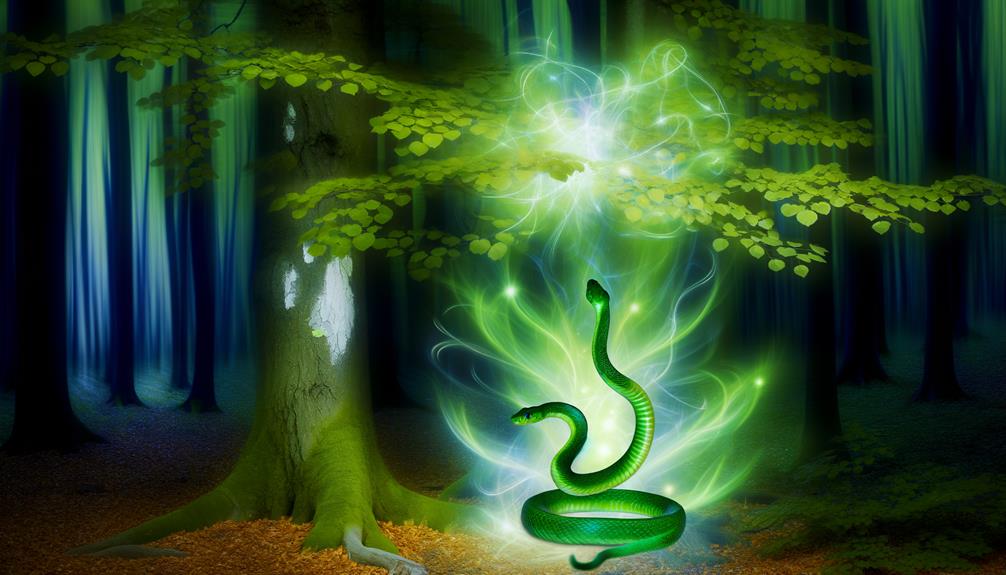
A green snake in a dream often signifies growth, renewal, and potential transformation, stemming from its vibrant color and the snake’s traditional symbolism.
Analyzing this imagery through a biblical lens reveals multiple layers of meaning. Green, a color traditionally associated with life and fertility, suggests burgeoning opportunities and spiritual rejuvenation.
The snake, while frequently emblematic of danger or deceit, also represents wisdom and healing, as seen in the biblical brass serpent that Moses raised in the desert.
Consequently, a green snake may symbolize a period of personal or spiritual growth, urging the dreamer to embrace change and self-discovery.
This interpretation underscores the duality of the snake’s nature, highlighting both its perilous and redemptive capacities in the context of the dreamer’s life.
Temptation and Sin
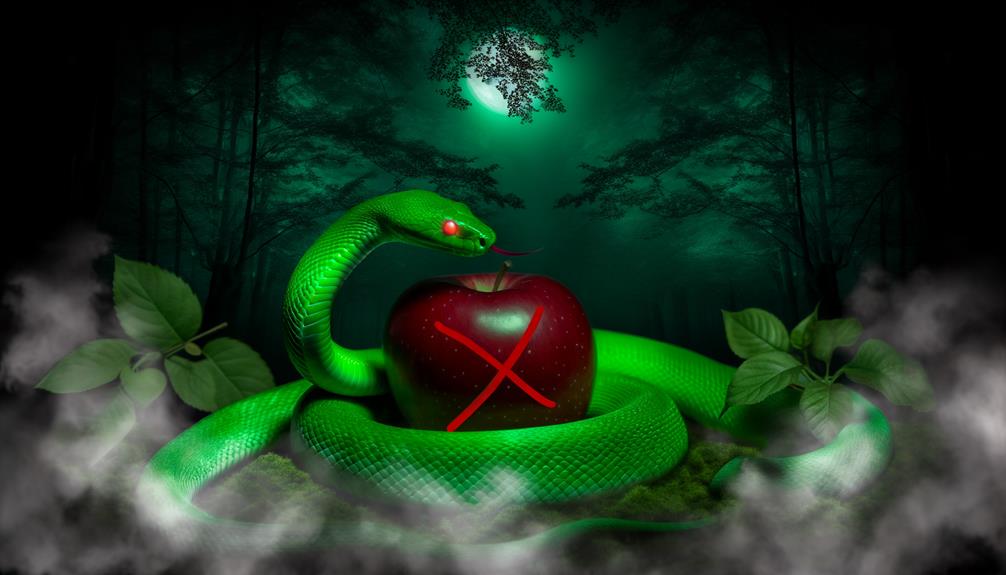
The imagery of a green snake in dreams often evokes the biblical narrative of temptation and sin, exemplified in the story of Adam and Eve.
Analyzing this symbolism through a theological lens reveals the subtle ways in which temptations manifest and challenge one’s moral integrity.
Understanding and overcoming these temptations requires a nuanced interpretation of biblical teachings, emphasizing vigilance and spiritual resilience.
Symbolism in Dreams
Dreams featuring green snakes frequently embody themes of temptation and sin, often invoking imagery that traces back to biblical narratives and theological symbolism.
In many religious traditions, snakes serve as potent symbols of deceit and moral fallibility. The color green, while typically associated with growth and renewal, can paradoxically signify envy and greed when combined with the serpent motif.
This duality underscores the complex nature of moral struggles, where paths to virtue are often fraught with trials. Analyzing such dreams requires an understanding of how these symbols interact within the psyche, reflecting internal conflicts and ethical dilemmas.
Consequently, the green snake becomes a multifaceted emblem, encapsulating the tension between spiritual ascent and moral descent in the dreamer’s subconscious.
Biblical Interpretations
Biblical interpretations of green snake dreams often underscore themes of temptation and sin, rooted in scriptural accounts such as the serpent’s deception in the Garden of Eden.
In Genesis 3:1-5, the serpent cunningly entices Eve, leading to the original sin and humanity’s subsequent fall. This narrative establishes the serpent as a symbol of deceit and moral downfall.
The green snake, with its vibrant yet potentially insidious appearance, may further suggest an alluring yet perilous temptation. Such dreams can serve as a conduit for reflecting on one’s spiritual vulnerabilities and the ever-present risk of succumbing to sinful desires.
Overcoming Temptations
Addressing the concept of overcoming temptations in the context of green snake dreams necessitates a nuanced exploration of one’s spiritual resilience and ethical fortitude.
In biblical symbolism, snakes often signify temptation and sin, drawing parallels to the serpent in the Garden of Eden. A green snake, however, introduces an element of growth and renewal.
This dual symbolism suggests that encountering a green snake in a dream may represent not only the presence of temptation but also the potential for personal growth through overcoming such challenges.
To interpret this dream, one must consider their own moral and spiritual journey, recognizing that the act of resisting temptation fortifies one’s ethical integrity and aligns them more closely with divine principles.
Transformation and Renewal
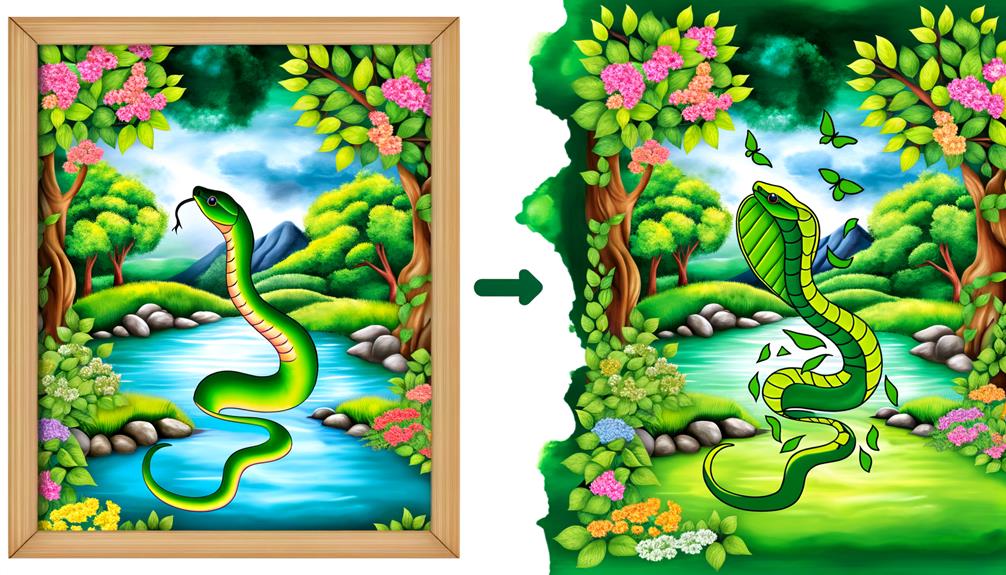
Interpreting the symbolism of a green snake in a dream through the lens of biblical exegesis often underscores themes of transformation and renewal. This interpretation draws from various scriptural passages that emphasize the metamorphic nature of spiritual growth and the renewal of one’s inner being.
The green snake may signify:
- Rebirth: Echoing the concept of being ‘born again’ as described in John 3:3.
- Repentance: Illustrating the act of turning away from past sins and renewing one’s commitment to God.
Such symbolism encourages believers to embrace change, viewing it as an essential aspect of their spiritual journey towards deeper faith and understanding.
Spiritual Awakening
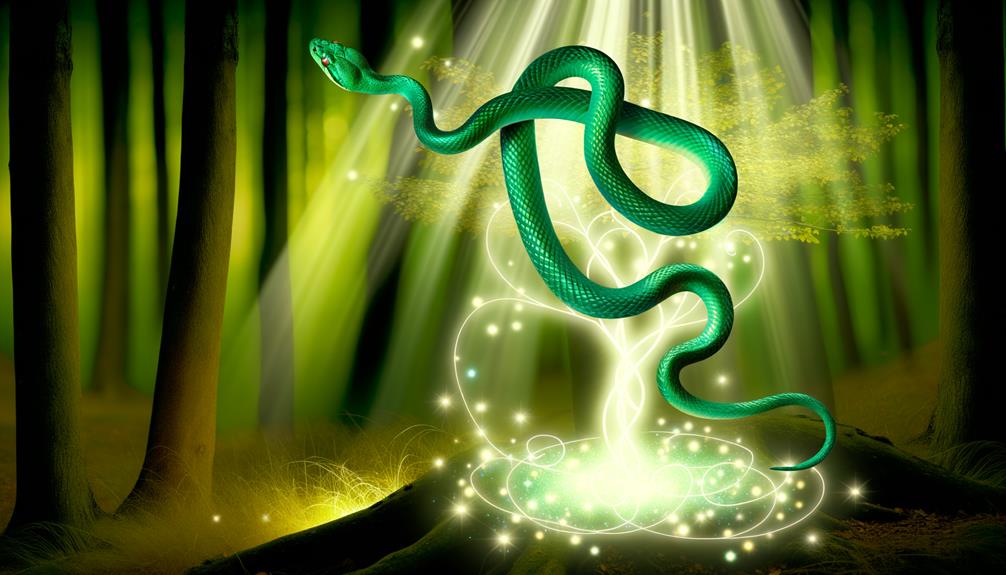
The green snake in biblical dream interpretation often symbolizes a profound spiritual awakening, representing growth, renewal, and the shedding of old habits.
This symbolism is particularly significant as it aligns with the transformative nature often attributed to snakes, which are frequently seen in religious texts as harbingers of change.
Analyzing these elements within the context of a dream can provide insights into the dreamer’s spiritual journey and emerging consciousness.
Significance of Green Snake
A green snake in a dream often symbolizes spiritual awakening, representing the emergence of new growth, healing, and transformation within one’s inner life. This vivid imagery suggests a profound shift in consciousness, where the dreamer is invited to explore deeper aspects of their spiritual journey.
The green snake can be viewed as a guide, leading one towards enlightenment and self-discovery. Analyzing the dream through an exegetical lens reveals several layers of meaning:
- Regeneration: Symbolizes the renewal of one’s spirit and the shedding of old habits.
- Healing: Represents emotional and spiritual healing processes.
Such dreams encourage introspection and the embrace of newfound spiritual insights.
Symbolism in Dream Interpretation
Dream symbolism often serves as a profound conduit for understanding spiritual awakening and the intricate layers of the subconscious mind. Within the domain of dream interpretation, symbols act as metaphors, revealing hidden truths and inner transformations.
The green snake, in particular, embodies a dualistic nature—symbolizing both regeneration and potential danger. This dichotomy reflects the transformative journey of spiritual awakening, where one must navigate through perilous self-discovery to attain enlightenment.
Biblical contexts further enrich this interpretation, as snakes often represent wisdom and cunning. As a result, encountering a green snake in a dream may signify an impending spiritual metamorphosis, urging the dreamer to embrace change while exercising discernment. In the biblical story of Adam and Eve, it is a cunning serpent that tempts Eve to eat the forbidden fruit, leading to a dramatic shift in their spiritual state. This reinforces the idea that encountering a green snake in a dream could be a sign of impending change and the need for wisdom in navigating it. In fact, the concept of ‘snake bite dream meaning bible‘ is a common search query, highlighting the prevalence of such symbolism in religious and spiritual teachings.
Such symbolism underscores the profound, often paradoxical, nature of spiritual growth.
Warning Signs
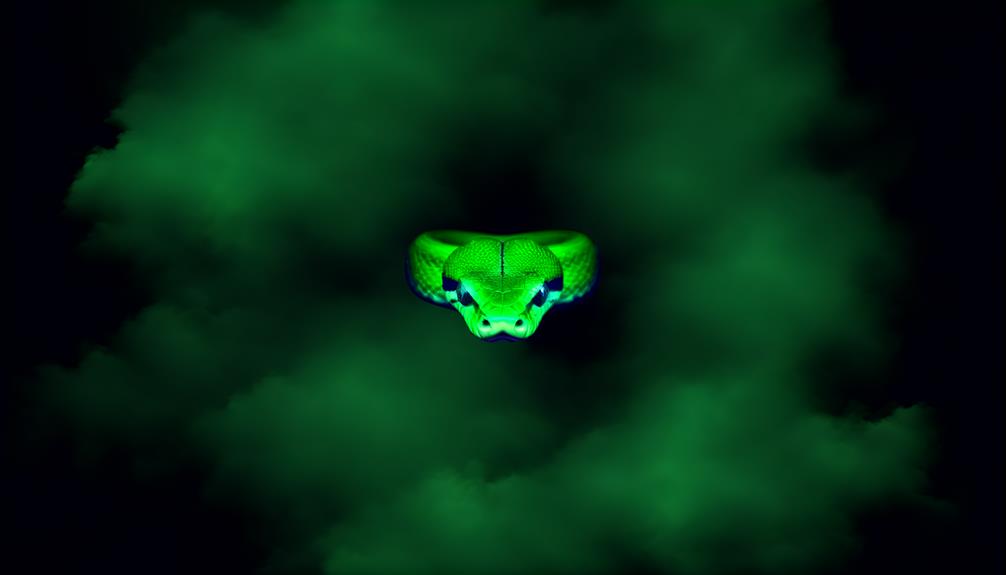
Interpreting the presence of a green snake in dreams often highlights underlying warning signs indicative of potential deceit, hidden threats, or unresolved conflicts in one’s waking life.
This serpentine symbol serves as a harbinger, urging the dreamer to exercise heightened vigilance and introspection.
Key elements to reflect upon include:
- Deception: The green snake may symbolize a duplicitous individual or situation that requires careful scrutiny.
- Latent threats: It can also represent subtle dangers lurking beneath the surface, necessitating preemptive measures.
Analyzing these elements within the dream context can offer profound insights, enabling individuals to address and mitigate the forewarned adversities effectively.
Healing and Restoration

The appearance of a green snake in dreams, while often associated with warnings, can also symbolize the potential for profound healing and restoration in the dreamer’s life.
In biblical contexts, the color green frequently signifies growth and renewal, aligning with the regenerative aspects of nature.
The serpent, often viewed as a harbinger of wisdom, may therefore represent an awakening to new insights that facilitate emotional or spiritual recovery.
This dual symbolism suggests that encountering a green snake could indicate an impending phase of rejuvenation, where the dreamer might overcome past traumas or illnesses.
Consequently, interpreting the green snake as a positive omen underscores the transformative power inherent in facing and integrating previously unacknowledged truths or experiences for holistic healing.
Personal Growth

Within the framework of personal growth, the green snake in a dream may symbolize the dreamer’s journey towards self-awareness and inner transformation. This imagery can be interpreted through various lenses:
- Psychological Rebirth: The green snake may represent shedding old habits and embracing new, healthier behaviors.
- Navigating Change: The snake’s ability to shed its skin parallels the individual’s capacity to adapt and evolve.
Analyzing these aspects reveals that the green snake in a dream serves as a potent emblem of metamorphosis. It encourages the dreamer to confront personal challenges and embrace the continuous process of growth, aligning with broader themes of self-improvement and enlightenment.
Divine Messages
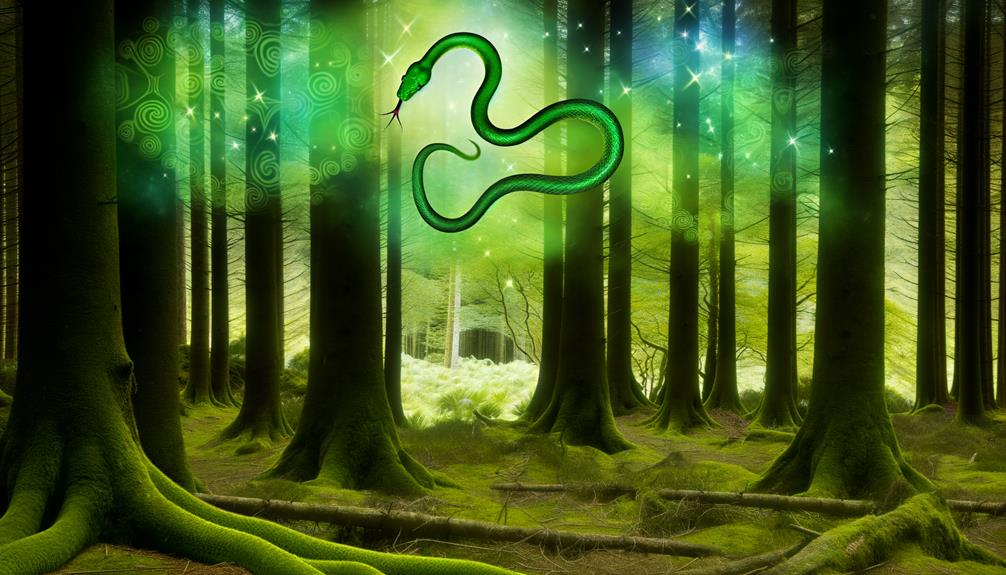
Dreams featuring a green snake may also be interpreted as divine messages, signifying spiritual guidance or warnings from higher powers.
Within theological exegesis, serpents often symbolize profound wisdom or impending peril. The green coloration, associated with life and renewal, may emphasize a divine call toward spiritual awakening or rejuvenation.
Scriptural texts frequently utilize serpentine imagery to convey God’s intricate plans, whether in the form of cautionary tales or transformative experiences. Consequently, such dreams might serve as metaphysical admonitions, urging the dreamer to heed celestial counsel or pursue a path of moral rectitude.
Understanding these dreams through a biblical lens requires a nuanced appreciation of symbolic theology, recognizing the potential for divine communication within the subconscious domain.
Practical Applications

Interpreting green snake dreams through a biblical lens not only offers spiritual insights but also provides practical applications for daily life. The symbolism of the green snake can be applied in various contexts to improve one’s spiritual journey and personal growth.
Self-Reflection: Encourages individuals to examine areas of their lives where they might be facing deception or temptation, fostering greater self-awareness.
Spiritual Renewal: Acts as a catalyst for seeking forgiveness and spiritual renewal, prompting a closer relationship with God.
Discernment: Enhances one’s ability to discern between good and evil influences, aiding in wiser decision-making.
Conclusion
The green snake, a biblical symbol, intertwines themes of temptation, sin, transformation, and renewal.
In this allegorical dreamscape, the serpent’s verdant hue signifies healing, restoration, and personal growth.
Divine messages, cloaked in serpentine form, challenge the dreamer to decipher their spiritual significance.
Yet, one must ponder: are these dreams mere nocturnal musings or divine communications?
Such interpretations beg the question if humanity’s quest for meaning is as serpentine as the symbols it seeks to unravel.






